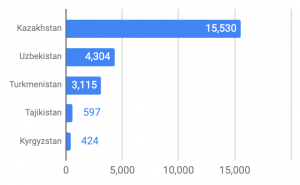The recently unveiled vision of the European Union on Asia proposed connectivity as the heart of the relationship. This novel concept is set to become relevant for the EU’s relations with Central Asia as well, given the latter’s location between Europe and Asia. As a form of feedback on a new EU strategy for Central Asia, due by end of 2019, this policy paper draws attention to three challenges that will undermine Central Asian states’ commitment to full-fledged connectivity. These include the constraints imposed by aspects of the region’s existing and growing connections with Russia and China, further compounded by the poor state of intra-regional connectedness. The paper focuses on two smaller states of the region, Kyrgyzstan and Tajikistan.
Introduction
A new strategy of the European Union on Central Asia is due to be adopted by the end of 2019. Recommendations in the course of the preparatory discussions included familiar, though important, calls for a better balance of norms and interests of the regional and bilateral agendas.[1] Along with these, a novel concept, ‘connectivity’, appears to become an important framework for the EU’s engagement with Central Asia. In fact, connectivity was recently unveiled as the heart of Europe’s new vision for Asia, not Central Asia. But, as the EU High Representative-Vice President Federica Mogherini recently emphasised, connectivity would be relevant for Central Asia too, which is “the crossroads, the meeting point of two continents”.[2]
If Central Asia is to be included in the EU’s “connectivity” paradigm, a closer look at the region’s state of international connectivity is necessary. First, the region has developed peculiar connections with other major extra-regional powers, namely Russia and China. Second, the countries of the region remain remarkably under-connected with, if not disconnected from, each other. These may affect the level of commitment that Central Asian leaders can take with the EU. But, more importantly, these (dis)connections reveal the kind of problems that make the EU’s support to Central Asia even more important. The discussion proceeds with a focus on the smaller and poorer states of the region, Kyrgyzstan and Tajikistan.
Central Asia’s need for the right kind of connectivity
Much praised as an ancient Silk Road land, the region was effectively a dead-end in the early 1990s, burdened by both distance from “lucrative markets” and proximity to “unattractive neighbours, would-be hegemons and war-torn states”.[3] Intra-regional connections have never thrived, making scholars see Central Asia as one of the most “dis-integrated and disconnected regions in the world”.[4] To be sure, there are areas where Central Asia has actually grown well connected to the wider world. Thus, while the movement of legitimate goods faced severe restrictions, the region has long turned into a major transit zone for narcotics. Similarly, while an ordinary Central Asian cannot freely travel to the US or Europe when she/he wishes to do so, the ruling elites have long become generous customers of Western banks and real estate agencies.[5] The challenge, thus, is how could Central Asia connect to the world in ways that would benefit a broader population in a sustainable way?
The EU’s concept of connectivity provides an attractive response to the above question. Connectivity is defined as being “about bringing countries, people and societies closer together”.[6] In a broader sense, “connectivity” appears a refreshed take on what once were the mainstream concepts of regional integration and globalisation. The Joint Communication, though, adds its own touch, stressing “the European way” of connectivity to be “sustainable, comprehensive and rules-based”, promoted through building transport corridors, digital connections, people’s movement and standards and rules to networks “interoperable”.[7]
Beyond sounding a progressive concept in itself, connectivity will clearly resonate with the needs of Central Asia. The intra-regional trade remains limited, while external trade routes are anything but balanced. The change of leadership in Uzbekistan led to a more open foreign policy, creating a window of opportunity for greater connectivity projects in the region. This said, there are several aspects of Central Asian connectivity today that shall inform the EU’s strategy. First, Central Asian states are already engaged in forms of connectivity with other extra-regional powers. Second, the discrepancy and disconnectedness between Central Asian states remain staggering.
Russian connection: remittances
As the Soviet Union collapsed, the newly independent Central Asian states were seen as little more than the Russian underbelly. Much changed since then, not least due to the inability of Russia to compete with the West and, more recently, with China, as a source of economic support for the region. Russia remained the primary extra-regional actor, however, not least through its political-military influence and dominance in mass media. A number of inter-state alliances, such as the Collective Security Treaty Organisation or the Eurasian Economic Union (EAEU) further bind the countries of the region to Russia. These should not, however, overshadow the salience of a less visible but no less consequential channel of the Russian connection to two issues of stake to the smaller states of the region: labour migration and remittances.
Kyrgyzstan and Tajikistan are in the world’s top three remittance-dependent countries. In 2017, for instance, remittances amounted to 32.9 per cent and 31.6 per cent of their GDPs.[8] In 2008 the figure for Tajikistan was staggering 49.3 per cent. The transfers are sent mostly from Russia, which hosts about 700,000 Kyrgyz and over one million Tajik citizens as labour migrants, over 10 per cent of their populations. Given high unemployment and poverty levels, particularly in rural areas, remittances are vital not only for households’ daily well-being but also for sustaining the local economies.
Labour migration is not only a matter of economic well-being. The sheer number of Kyrgyz and Tajiks living and earning in Russia make this a major political and policy issue. The well-being of Kyrgyz and Tajiks in Russia, many living on dubious legal grounds, is often found in direct correlation with the state of bilateral relations. During heated debates in Kyrgyzstan over joining the EAEU, the benefits (from accession) and potential damage (in case of non-accession) for Kyrgyz migrants in Russia turned out to be one of the major selling points for EAEU. Similarly, Tajik analysts linked Dushanbe’s reluctance to join the EAEU as one of the reasons for a growing number of deportations of Tajik citizens from Russia in 2016.[9]
Chinese connection: debt and road diplomacy?
Central Asia’s connections with China are ever growing. Due to its location, Central Asia is naturally involved in the Chinese grand project, the Belt and Road Initiative (BRI). Of the six land corridors envisaged, two are supposed to cross Central Asia. So far, the BRI has little to demonstrate in Central Asia. But China’s role should not be assessed by the progress in actual highways constructed only. The BRI builds on, gives a name to, and potentially expands on the already massive engagements that China has developed with Central Asia since the 2000s. This engagement is best observed in relation to China’s sovereign loans in Kyrgyzstan and Tajikistan.
As of early 2018, over 40 per cent of the external debt of Kyrgyzstan and Tajikistan was owned by China (see Chart 1). The figure is much higher if one looks at loans received in recent years. The emergence of China as a lender in the late 2000s matched perfectly with the acute need for basic infrastructure investments in Kyrgyzstan and Tajikistan, mainly in roads and the energy sector. Chinese loans were preferred to others. In the words of the Kyrgyz deputy Finance Minister, they brought “less burdensome conditions” and did not demand co-funding.[10] That said, the lack of strict transparency requirements also made Chinese loans preferred. Two former Prime Ministers of Kyrgyzstan were arrested in 2017 accused of “lobbying” a nearly 400-million Chinese loan for the renovation of the Bishkek heating station. While this is likely to be an instance of political infighting than fighting corruption, the case of the defendants is not helped by an absence of meaningful documentation on how the money was actually spent.[11]
Chart 1 External debts of Kyrgyzstan and Tajikistan, in billion USD, 2018.[12]


How the staggering level of sovereign debts to China will play out is still to be seen. Optimists suggest that the economic growth in recipient countries will allow comfortable repayment.[13] But there are signs that the growing debts may turn China into a bigger actor in the region’s economy. The recent decision of the Tajik government to issue a license for a gold mine to the Chinese TBEA company points to one of the ways in which the loans can help China to expand its role in the local economies of Central Asia.[14] Beijing might also be growing more comfortable about being less benign with Central Asians. Citing a blast at its embassy in Bishkek in 2016, China severely toughened visa issuance for Kyrgyz citizens, true to this day. In the words of Kyrgyz businessmen, this led to Chinese lorry drivers to overtake the roads and drive Kyrgyz out of business.[15]Traders of renowned bazars, such as Dordoi, in turn, speak about acquiring a Kazakh citizenship as an easier way to travel to China for goods than trying it with a Kyrgyz passport.
Intra-regional disconnections
The third potential obstacle for Kyrgyzstan and Tajikistan to connect is internal. Both countries have a troubled history with Uzbekistan, the most populated and centrally located country of the region. The list of unresolved problems is long, featuring conflicts over trans-boundary water resources, energy supplies and incomplete border delimitation. The new leadership in Tashkent appears more open to sit and discuss such matters, but tangible changes in relations to these remain to be seen.
Bilateral matters aside, the connectivity of Kyrgyzstan and Tajikistan into a wider economic network is hampered by the smallness of their markets, the under-developed economies and difficult terrain. The countries lack major energy resources and are avoided as potential transit territories for energy pipelines.[16]In addition to small size economies, the countries’ populations are also poorer compared to other countries in the region (see Chart 2). They are compounded by a mountainous terrain that severely limits possibilities for railways and highways. Kyrgyzstan and Tajikistan have shortest railroads systems (Chart 3). Striving to cut dependence on each other, Central Asian states have managed to destroy the Soviet-built common transport and electricity networks.[17]
Chart 2 GDP per capita, PPP (current international US$), 1997-2017.[2]
[1] Compiled from World Bank Databank, https://data.worldbank.org/indicator/IS.RRS.TOTL.KM?view=chart
Chart 3 Length of railroads, in km.
[2] Compiled from World Bank Databank, http://databank.worldbank.org/data/home.aspx.
Conclusion
The three issues reviewed above do not pose an obstacle to the EU strategy in Central Asia. Clearly, Brussels is not in geopolitical competition against other powers in the region. Yet, the above discussion points to one problem that is central to the EU as well: the weakness and vulnerability of Central Asian states and societies. Labour migrants in Russia give Moscow political leverage. This is a cause of the economic collapse of emigrating Central Asian countries. Chinese loans might have turned Beijing into a more influential actor in Central Asia, perhaps also feeding corrupt elites on both sides of the aisle along the way. Yet, they proved crucial to reconstruct some failing infrastructure, including roads and energy facilities in Central Asia. This suggests that supporting a stable, developing and connected Central Asia requires, above all, strengthening local capacity in the region.
Supporting Central Asian states to grow as viable and politically stable states is easier said than done, and the “to-do” list would not be short. Below are only three of may possible proposals that the EU is well placed to address and could take into consideration.
First, today the EU is well-positioned to make a difference towards improving internal regional connectivity through encouraging more intense high-level communication. The EU is not seen as an actor engaged in great power rivalry in the region, which makes its presence welcome by both regional and non-regional actors. It is encouraging to see an increasing engagement of Brussels in “5+1” format as well as relentless activism in the region by the Special Representative for Central Asia. A shift towards greater openness for international engagements on the side of Uzbekistan might present a best possible circumstance from within the region. Internal connections primarily depend on Central Asians themselves, but given the conducive context, the EU should double down on its existing support for cross-border trade, freedom of movement and a burgeoning spirit of cooperation at higher levels.
Second, employment, and sustainable economic development more broadly, deserve to become key improvement in the region, and the EU should aim at those. This is relevant for the problem of labour migration, but in the longer-term, is also critical for stability and security in the region. Goals such as assisting the education sector, encouraging EU-oriented exports and improving accountability and transparency, should be planned and pursued with an eye on supporting small and medium businesses that create most jobs within the region.
Finally, the EU will promote benefits for itself and Central Asian states and societies by supporting regional expertise for policy research and analysis. If corruption is a known malaise of the governance in the region, incompetence is another. The combination does not make the governments too receptive of policy advice from outside. However, the need for such advice is palpable, and think tanks industry must grow to make itself relevant. Informing and engaging with a broader audience, beyond policy-makers, is no less important for research communities. The current “public” brainstorming for the new EU strategy for Central Asia has been exclusively driven by the EU. It remains to be seen whether and when would the Central Asian governments and policy community start strategizing their relations with the EU in the same way.
By Shairbek Dzhuraev, Jan 10, 2019*
Notes
* The paper was originally posted at “Around the Caspian: a Doctoral Training for Future Experts in Development and Cooperation with Focus on the Caspian Region”, at http://caspianet.eu/about/, on January 10, 2019.
[1] See Marlene Laruelle, Andreas Marazis, and Tika Tsertsvadze, “A New EU-Central Asia Strategy: Deepening Relationships and Generating Long-Lasting Impact,” EUCAM Working Paper, November 4, 2018, https://eucentralasia.eu/2018/11/a-new-eu-central-asia-strategy-deepening-relationships-and-generating-long-lasting-impact/, Katrin Böttger and Julian Plottka, “A New Start for the EU Central Asia Policy in 2021? Current State, Developments and Perspectives for the Revision of the EU Central Asia Strategy,” L’Europe en Formationn° 385, no. 1 (December 4, 2018): 45–60.
[2] European External Action Service, “Remarks by High Representative-Vice President Federica Mogherini at the Press Conference Following the EU-Central Asia Ministerial Meeting,” November 23, 2018, https://eeas.europa.eu/headquarters/headquarters-homepage/54363/remarks-high-representative-vice-president-federica-mogherini-press-conference-following-eu_en.
[3] Celeste Wallander, “Silk Road, Great Game or Soft Underbelly? The New US-Russia Relationship and Implications for Eurasia,” Southeast European and Black Sea Studies 3, no. 3 (September 2003): 98.
[4] Luca Anceschi, “The Resurgence of Central Asian Connectivity,” The Diplomat, December 1, 2017, https://thediplomat.com/2017/11/the-resurgence-of-central-asian-connectivity/.
[5] See Alexander Cooley and John Heathershaw, Dictators Without Borders: Power and Money in Central Asia, 1 edition (New Haven: Yale University Press, 2017).
[6] The Chairs’ Statement of the 13th ASEM Foreign ministers meeting in Na Pyi Taw, Myanmar, on 20-21 November 2017, available at https://www.mofa.go.jp/files/000309716.pdf.
[7] European Commission and High Representative of the Union for Foreign Affairs and Security Policy, “Connecting Europe and Asia – Building blocks for an EU Strategy”, Joint Communication, 19 September 2018.
[8] Ranking second and third respectively, after Tonga, and followed by Haiti. https://data.worldbank.org/indicator/BX.TRF.PWKR.DT.GD.ZS?end=2017&start=1970&view=chart&year_high_desc=true
[9] Asia-Plus, “The Number of Cases of Deportation of Tajik Citizens from Russia Increasing,” October 5, 2016, https://news.tj/en/news/tajikistan/society/20161005/231636.
[10] Bakyt Orunbekov, “Neubyvayushchii vneshnii dolg (Non-decreasing foreign debt),” February 15, 2018, https://rus.azattyk.org/a/kyrgyzstan_china_debt/29040734.html.
[11] Yulia Kostenko, “Schetnaya palata KR: pri modernizatsii TETS Bishkeka ne byli sostavleny smety raskhodov (Accounting Chamber of the Kyrgyz Republic: No cost estimates were made when upgrading Bishkek’s heat and power plant),” 24.kg, November 17, 2017, https://24.kg/ekonomika/68543_schetnaya_palata_kr_pri_modernizatsii_tets_bishkeka_nesostavlenyi_smetyi_rashodov/.
[12] Avesta, “Tadzhikistan Dolzhen Kitayu Svyshe $1,2 Mlrd (Tajikistan Owes China over $ 1.2 Billion),” Avesta, February 20, 2018, http://avesta.tj/2018/02/20/tadzhikistan-dolzhen-kitayu-svyshe-1-2-mlrd/., Aidai Erkebaeva, “Kyrgyzstan ustanovil limit dolga pered kreditorami. Chto eto znachit? (Kyrgyzstan has set a limit on debt to creditors. What does it mean?),” Kloop.Kg, March 26, 2018, https://kloop.kg/blog/2018/03/26/kyrgyzstan-ustanovil-limit-dolga-pered-kreditorami-chto-eto-znachit/.
[13] Dirk van der Kley, “Can Central Asia’s Poorest States Pay Back Their Debts to China?,” The Diplomat, December 1, 2017, https://thediplomat.com/2017/12/can-central-asias-poorest-states-pay-back-their-debts-to-china/.
[14]Eurasianet, “Tajikistan: Chinese Company Gets Gold Mine in Return for Power Plant”, April 11, 2018, https://eurasianet.org/tajikistan-chinese-company-gets-gold-mine-in-return-for-power-plant.
[15] Radio Azattyk, “Poluchit’ vizu v Kitai stalo slozhnee (Receiving Chinese visa became more complicated),” February 23, 2017, https://rus.azattyk.org/a/28326412.html.
[16] Thus, in 2007 the Kyrgyz prime minister Atambaev explicitly asked Chinese Hu Jintao to make the planned Turkmen-Chinese gas pipeline to cross Kyrgyzstan. This was proved in vain three days later, with the route approved to bypass Kyrgyzstan. See Obschestvennyi Reiting, “Nadezhdy Kyrgyzstana Provesti Gazoprovod Turkmenistan-Kitai Cherez Svoyu Territoriyu Ne Opravdalis’ (Kyrgyzstan’s Hopes to Have Turkmenistan-China Gas Pipeline Cross Its Territory Did Not Materialize),” August 20, 2007, http://www.pr.kg/old/archive.php?id=18961.
[17] One latest development was the completion of Angren-Pop railway by Uzbekistan in 2016, bypassing northern Tajikistan. See Radio Azattyq, “Tashkentu bol’she ne nuzhna zheleznaya doroga cherez Tadzhikistan (Tashkent no longer needs railway through Tajikistan),” February 26, 2016, https://rus.azattyq.org/a/uzbakistan-zheleznaya-doroga-tajikistan/27575251.html
[18] Compiled from World Bank Databank, https://data.worldbank.org/indicator/IS.RRS.TOTL.KM?view=chart
[19] Compiled from World Bank Databank, http://databank.worldbank.org/data/home.aspx.



